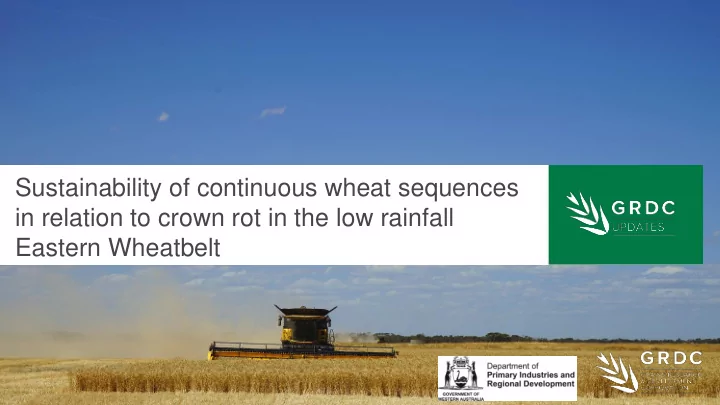

Sustainability of continuous wheat sequences in relation to crown rot in the low rainfall Eastern Wheatbelt
Bob French A and Shahajahan Miyan B DPIRD A Merredin and B Northam
BACKGROUND • Wheat after wheat is common in WA, especially in low rainfall areas and on loamy soils • This is despite the well known benefits of break crops for system sustainability • Can management of continuous wheat prolong system sustainability?
Where is crown rot in WA? – Stubble plating survey 2012-2013 Crown rot incidence in paddocks: National crown rot project 4 (DAN00175)
Wheat yield loss – met-analysis 2014-2016 Yield loss to crown rot (%) (Huberli et al . Crop Updates 2017) 45 Yield loss categories 40 0-10% Low 35 10-20% Medium 30 25 >20% High 20 15 10 5 0 Emu Rock Justica CL Wyalkatchem Magenta Mace Cobra Calingiri Harper Westonia Yitpi Corack Trojan Scepter National crown rot project (DAN00175) –
TRIAL DESIGN Six sequences 2015 2015 2016 2016 2017 2017 2018 2018 2015 2016 2017 2018 Wheat Wheat Wheat Wheat Wheat Wheat Wheat Wheat Wheat Wheat Wheat Wheat Canola Wheat Wheat Wheat Canola Canola Wheat Wheat Wheat Wheat Wheat Wheat Fallow Wheat Wheat Wheat Fallow Fallow Wheat Wheat Wheat Wheat Wheat Wheat Fallow Canola Wheat Wheat Fallow Fallow Canola Canola Wheat Wheat Wheat Wheat Canola Fallow Wheat Wheat Canola Canola Fallow Fallow Wheat Wheat Wheat Wheat Wheat Fallow Canola Wheat Wheat Wheat Fallow Fallow Canola Canola Wheat Wheat
Previous crop did not affect wheat yield in 2016 2.5 2.5 2.0 2 Grain yield (t/ha) 1.5 Emu Rock 1.5 Mace 1.0 1 Magenta Average 0.5 0.5 0.0 0
Sequence did not affect wheat yield in 2017 2.0 2 Grain yield (t/ha) 1.5 1.5 Emu Rock 1.0 1 Mace Magenta 0.5 0.5 Average 0.0 0
Initial crown rot levels were high • In 2015 crown rot organism isolated from ~12% of crowns remaining from 2014* • Predicta B: high levels of crown rot DNA in soil, low or nil levels of other soil borne diseases * GRDC National Crown Rot Project (DAN00175)
Crown rot expression
Sequence and cultivar both affect crown rot severity 50 2017 2016 45 40 Crown rot severity 35 30 25 Emu Rock 20 15 Mace 10 Magenta 5 0
Sequence and cultivar both affect soil crown rot DNA levels 3.0 Crown rot DNA (log(pg/g soil +1)) 2016 2017 2.5 2.0 1.5 Emu Rock 1.0 Mace 0.5 Magenta 0.0
Soil DNA levels are related to crown rot severity in previous year 3.0 R² = 0.8582 2.5 2017 Predicta B 2.0 Magenta Emu Rock 1.5 Mace 1.0 0.5 0.0 0 20 40 60 80 100 2016 crown rot incidence (%)
Sequence and crop competitiveness affect ryegrass head numbers Mean ryegrass heads/m² in October 2015 2015 2016 2017 18 All cropped plots 18 Fallow <1 <1 <1 <1 14 Canola 14 2 9 Wheat after wheat 2 9 20 Wheat after canola 20 45 Emu Rock – cont. wheat 45 Emu Rock – after canola 54 54
CONCLUSIONS • Continuous wheat can be sustainable for at least 4 years on a loamy soil with a crown rot background • Emu Rock has lower crown rot expression than Mace or Magenta and lower inoculum carry-over to the following season. • Competitive crops are crucial in preventing weed blowouts
Thank you Merredin Research facility staff Shahajahan Miyan Bruce Haig Julia Tilli GRDC co-invested in this work as part of project DAW00249 Grains Research and Development Corporation (GRDC) A Level 4, East Building, 4 National Circuit, Barton, ACT 2600 Australia P PO Box 5367 Kingston, ACT 2604 Australia T +61 2 6166 4500 F +61 2 6166 4599 www.grdc.com.au @thegrdc @GRDCWest #GRDCUpdates
Recommend
More recommend